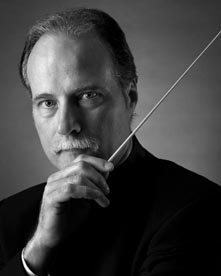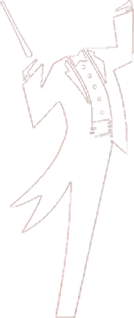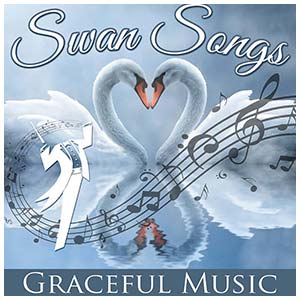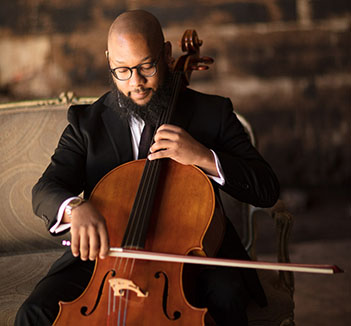Prelude to Act III of Lohengrin
Wilhelm Richard Wagner (1813 – 1883)
Concerto No. 1 for Cello in C Major
Joseph Haydn (1732 – 1809)
Ryan Murphy, cello soloist
The Swan from Carnival of the Animals
Camille St. Saens (1835 – 1921)
Ryan Murphy, cello soloist
Overture for the End of a Century
Libby Larsen (1950 – )
Suite from Swan Lake
Pyotr Ilyich Tchaikovsky (1840 – 1893)

Gene Dowdy
Conductor & Artistic Director
Conductor’s Letter
Dear Symphony of the Hills’ Friends,
Welcome to the 19th season of the Symphony of the Hills! Our first concert features some of the greatest music for symphony orchestra that is inspired by tales involving one of nature’s most beautiful and regal creatures, the swan. One of the rare animal species who choose their mates for life, the swan has been celebrated as a symbol of both light and also departure as seen from Greek mythology until modern times. In Hindu culture, the swan is recognized as a creature who, like saintly persons, can be in the physical world without becoming attached to it. The main character in Wagner’s opera Lohengrin rides in to rescue his soon-to-be-bride on a boat drawn by a swan. Wagner’s music is scintillating full of color, emotion, and strength. Since one of the most famous swan songs ever composed (St. Saëns’ “The Swan” from Carnival of the Animals), which features a cello solo, we will also present Haydn’s Cello Concerto No. 1, played by San Antonio Symphony cellist, and Sphinx Competition artist, Ryan Murphy.
The second half of the program opens with Libby Larsen’s swan song to the 20th Century entitled “Overture for the End of a Century”. It is impressive to see the rise of women composers in the last 50 years, and Grammy Award-winning Libby Larsen is one of our country’s best known. Finally, we will present Tchaikovsky’s ballet music to Swan Lake, which contains some of the most beautiful and recognized orchestral music in the repertoire.
I hope to see you there!
With sincere thanks for your support,
Gene Dowdy, Conductor & Artistic Director
Concert Notes
The swan has been featured in musical compositions for hundreds of years. Its graceful motion evokes a serenity that composers over centuries have attempted to represent in musical passages. Tonight’s music will celebrate this beautiful creature and should leave us in an especially tranquil mood as we bid a belated goodbye to the 20th Century.
Prelude to Act III of Lohengrin
Wilhelm Richard Wagner (1813 – 1883)
Lohengrin is a 3-act opera created by Richard Wagner, who wrote 13 operas over 50 years, a monumental contribution to the arts. Even more remarkable, he wrote both the music and the lyrics (the libretto) for all of his lengthy stage works. His operas are notable for their complex textures, incorporating the use of leitmotifs—musical phrases associated with individual characters, places, ideas, or plot elements. Wagner was a master at telling a story, with elaborate and intriguing plots, beautiful stage sets and electrifying music.
Born in the Jewish Quarter in Leipzig, Wagner was not Jewish; he was baptized at an early age in the Lutheran St. Thomas church of that city. He demonstrated a natural talent in music and written composition in his youth. At 14 years of age, Wagner created Leubald, his attempt at a tragic drama loosely based on a Shakespearean theme. His first opera he composed at age 16. His inspiration for subsequent works came from German legends, myths, tales, Shakespeare’s plays, and contemporary commentary.
Lohengrin, a stirring and well-recognized work from which tonight’s selection is taken, is a Romantic opera derived by Wagner from a medieval epic poem about a knight of the Holy Grail who is sent (on a boat pulled by swans) to rescue a maiden in distress. It was first performed in Bayreuth, Germany in 1850. (Perhaps of interest is that the well-known castle centerpiece in Disneyland was inspired by Mad Ludwig’s Bavarian castle Neuschwanstein, in turn, inspired and named after the swan knight Lohengrin.) The music certainly conjures up visions of castles and a magnificent knight in shining armor.
Concerto No. 1 for Cello in C Major
Joseph Haydn (1732 – 1809)
Chamber music is not popular in America. Some would say that it’s an acquired taste. That is perhaps unfortunate since it is a demonstrated stress reducer . . . it has a soothing aspect and a calming effect. In any case, the genre benefited significantly from the creativity of Joseph Haydn. His contributions to the musical format earned him the titles “Father of the Symphony” and “Father of the String Quartet”
For much of his career in the late 18th Century, Haydn was the most celebrated composer in Europe. He was a friend and mentor of Mozart and a tutor of Beethoven. His work concentrated on the development of the sonata form of musical composition but differed in some ways from that of Mozart and Beethoven, who further developed the structure.
Haydn, born in Austria close to the border with Hungary, was musically gifted at an early age and was encouraged by his parents to pursue music as a career. He struggled at first, working as a music teacher, a street musician and an accompanist for an Italian composer. As his skills increased, Haydn gained a widespread and favorable reputation, greatly enhanced by two visits to London where his compositions got broad exposure. Audiences in London flocked to Haydn’s concerts; his fame spread and he became financially secure. Between Haydn’s visits to London, he returned to Vienna for two years during which Beethoven relocated there to become one of Haydn’s pupils.
The Concerto for Cello we will hear tonight, written about 1765, was presumed lost until 1961 when it was discovered at the Prague National Museum. It is in the sonata form in three movements, and clearly demonstrates Haydn’s mastery of instrumental composition.
The Swan from Carnival of the Animals
Camille St. Saens (1835 – 1921)
Ryan Murphy, cello soloist
St. Saens was a French pianist and composer of the Romantic era, born in Paris and at an early age recognized as a musical prodigy. He made his concert debut at age 10.
The Carnival of the Animals is a quasi-humorous musical suite of fourteen movements, each representing the artist’s ideas of a different animal . . . a lion, chickens, an elephant, etc., a real menagerie. A staple of the cello repertoire, the Swan is one of the most popular compositions of the Suite, immediately recognizable. St. Saens said that he had great fun writing the Suite while secluded in a small Austrian village. The piece is performed with a small ensemble meant to evoke a swan elegantly gliding over rippling water while the swan’s feet, hidden from view beneath the water, propels it along.
This well-known movement of the suite, usually in a version for cello with solo piano, is the only version of the work published during Saint-Saën’s lifetime,
Overture for the End of a Century
Libby Larsen (1950 – )
Written as a “swan song” for the Twentieth Century, this 1994 Larsen overture is a dramatic piece taking its melody, harmony and color from the traditions defining “the orchestra” in recent times. At the same time, the work explores approaches to sound which became part of our musical world toward the end of the last century: the mixing board, which combines musical fragments; the computer monitor, combining lines to provide images; and the synthesizer, with its entirely new sounds.
Libby Larsen is one of America’s most prolific and most performed living composers. She has created a catalogue of over 500 works covering virtually every genre from chamber music to massive orchestral works, including over 15 operas. Her music has been praised for its dynamic and vigorous contemporary American spirit. Ms. Larsen won a Grammy in 1993 and is the first woman to serve as a resident composer with a major orchestra. She has held residencies with the California Institute of the Arts, the Arnold Schoenberg Institute, the Philadelphia School of the Arts, the Cincinnati Conservatory, the Minnesota Orchestra, the Charlotte Symphony, and the Colorado Symphony.
Suite from Swan Lake
Pyotr Ilyich Tchaikovsky (1840 – 1893)
We are probably all familiar with Swan Lake, a ballet composed by Tchaikovsky in 1875. When initially performed it was a dismal failure (go figure!) and is now the most popular of all ballets. The ballet performance, initially in two acts, was fashioned from Russian and German folk tales which tell the story of Odette, a princess turned into a swan by an evil sorcerer’s curse, and Prince Siegfried, a handsome Prince who falls in love with Odette. The ballet premiered at the Bolshoi Theatre in Moscow in 1877. Although its presentation has taken many different forms, most ballet companies now employ a version of the work completed in 1895 for the Imperial Ballet in St. Petersburg. For that performance, Tchaikovsky’s score was revised by the St. Petersburg Imperial Theatre’s chief conductor and composer Riccardo Drigo.
Historical records don’t tell us who wrote the original plot for Swan Lake. Since the first published libretto does not correspond with Tchaikovsky’s music in many places, it’s conjectured that the first published version was written by a journalist after his viewing of the initial rehearsals of the ballet.
Some contemporaries of Tchaikovsky recalled the composer taking great interest in the life story of Bavarian King Ludwig II (“mad King Ludwig”), whose life had supposedly been marked by the sign of a Swan and who could have been the exemplar for Prince Siegfried. However, Ludwig’s death (was it murder?) happened 10 years after the first performance of the ballet. It doesn’t really matter… the music is magical.
Concert Notes by Jim Adams
Ryan Murphy, cello soloist
While still a student at the Cleveland Institute of Music with Stephen Geber, Ryan Murphy had already made his solo debut with the Detroit Symphony followed by an additional appearance with the Cleveland Orchestra. Both performances came as the result of placing second in the Sphinx Competition in 2003. His radio appearances have included the From The Top radio show at the Kennedy Center where he won the audience choice award and two appearances on Classic 99’s Young Heroes in Music show in St. Louis.
Mr. Murphy is an avid orchestral player and joined the San Antonio Symphony during the 2012-2013 season and became a tenured member of the cello section the next year. In the previous season he participated in the Pittsburgh Symphony’s OTPAAM program, which is an orchestral training program for African American and Latino musicians. During the summer he plays in the Colorado music Festival in Boulder. He also took part in the Julliard Centennial Orchestra Tour across America in 2006 while earning his masters degree as well as attended the PMF, Tanglewood, Kent Blossom, and Round Top festivals. In addition he is a former member of the National Philharmonic, Canton Symphony, and served as the assistant principal cellist in the World Youth Orchestra for Peace presenting concerts in Hiroshima and Nagasaki to commemorate the 70th anniversary of the atomic bombings of those two cities. He was also principal cellist of the Red Bull Artsehcro with presented a concert in Carnegie hall and premiered a concerto for DJ and orchestra.
As a chamber musician Mr. Murphy has made appearances with the Mid Texas Chamber Players, Musical Offerings, and Camerata San Antonio. He also has participated in various national tours of the Sphinx Virtuosi and has been featured on chamber music programs for the Colorado Music Festival.
The aspect of cello Mr. Murphy finds to be the most gratifying are all the various cultural experience it has afforded him over the years. In addition to playing in Japan he was fortunate to travel to Zimbabwe on three separate occasions with the Cultures in Harmony chamber music group. He is also passionate about musical outreach and has performed on programs across the country to spread his passion for classical music and the cello.
Mr. Murphy performs on a 1998 Peter Staszel cello on permanent loan to him from the Chicago workshop of William Harris Lee & Co.





